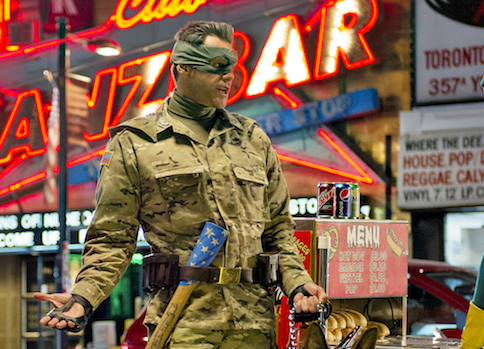The central question in the Kick-Ass series is whether or not the films are a critique of comic book genre excess or simply an example of the same.
Kick-Ass 2 suggests that the latter is true.
Kick-Ass (2010) introduced us to Kick-Ass (Aaron Taylor-Johnson), a normal guy who decides to become a superhero. His bumbling misadventures get him in trouble with crooks, earning him a beating or three.
During one of these thumpings, Kick-Ass is rescued by Hit Girl (Chloe Grace Moretz) and Big Daddy (Nicolas Cage), a Batman-and-Robin-like father-daughter duo who aren’t above crippling or killing criminals.
Kick-Ass and Hit Girl have decided to team up as the sequel opens. She teaches him the ways of the vigilante, helping him bulk up and urging him to conquer his fear. However, after Hit Girl’s guardian finds out about her shenanigans she is forced to attend school and deal with a foe far worse than street thugs: mean girls.
Kick-Ass, meanwhile, decides to join another team of would-be heroes, this one led by Colonel Stars and Stripes (Jim Carrey). The good guys at first spend their nights performing community service. But soup kitchens soon lose their appeal, and the Colonel convinces them to rough up some real bad guys.
As this is happening, bad guy Chris D’Amico (Christopher Mintz-Plasse) builds a villainous team of his own. D’Amico seeks vengeance for the death of his father, killed at the hands of Kick-Ass in the first movie.
Writer-director Jeff Wadlow has a lot of balls in the air and can’t quite juggle them. This is one of the few films I can think of that would have benefitted from a slightly longer running time rather than a slightly shorter one.
While there are a few feeble attempts to show the silliness of the genre—Hit Girl cuts off the hand of a mugger while trying out one-liners, for instance—the tone is different this time around.
There is still a great deal of violence, but its impact is muted. After Carrey’s infamous denunciation of the film earlier this year, I was expecting a far bloodier romp than what ended up on the screen.
This is in stark contrast to the original.
The first film tried, with some measure of success, to pull off a far trickier act than balancing three concurrent stories. It was half comic-book action-comedy and half critique of comic-book action-comedy.
Kick-Ass was, by turns, very funny and uncomfortably brutal. In one scene, Kick-Ass and Big Daddy are tied to chairs and beaten by thugs with blunt objects. Big Daddy is then doused in gas and lit on fire. His daughter watches him die.
Cage’s performance, in which he more or less played Adam West playing Batman, gave the proceedings a feeling of parody. And the behavior of Big Daddy—a disgraced cop who exulted in murdering criminals and turned his tween daughter into a remorseless killing machine with a foul mouth—suggested director and co-writer Matthew Vaughan was doing more than poking fun at the ethical underpinnings of a disreputable genre. He was laying waste to them.
The problem is that regardless of how sharp you make your satire—how insane you make Big Daddy seem, how viscerally you portray the violence—a well-choreographed fight scene undoes everything that came before. A balletic explosion of hand-to-hand violence is a remarkably powerful thing. It is, for lack of a better word, cool. It quickens the pulse and heightens the senses.
That biological response overwhelms whatever message the director is trying to send: Your brain may respond to the critique, but your body responds to the cool.
While criticism of the genre has been diminished in the sequel, the trappings of the genre have been enhanced. There are several excellent action sequences, including the best fight on the roof of a moving vehicle speeding down the highway since The Matrix Reloaded. (Granted, there haven’t been a ton of entries in that relatively specific category.)
Moretz is the best thing in the film, laying waste to the self-esteem of high school bullies and the bodies of D’Amico’s henchmen. Taylor-Johnson still feels a bit out of his depth in the title role, speaking in a marble-mouthed cadence that doesn’t quite work. And Carrey isn’t able to fill the shoes of Cage, whose inspired hamming was not only his finest performance in years but also the soul of the original film.
Kick-Ass 2 is fun enough in its own right. But in trading a modestly subversive critique for a modestly successful romp, it falls short of the expectations set by its predecessor.
